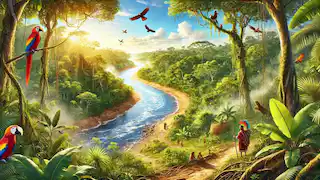Chapter 1: Origins and Discovery
Long before the explorers from Europe set their eyes on the dense and impenetrable jungles of South America, the Amazon River had already carved its path through the heart of the continent. The river's story begins with its origins, deep in the Andes Mountains, where it springs to life from melting snow and ice. This formidable river is born from small streams and brooks that converge, gaining strength and volume as they journey eastward, creating the majestic Amazon.
The indigenous tribes, such as the Yanomami and the Ticuna, have revered the Amazon River for centuries, considering it a sacred entity, the lifeblood of their existence. They have woven myths and legends around it, attributing it with godly powers. The river provided them with everything they needed: water, food, transportation, and a myriad of medicinal plants. Their deep respect for the river fostered a harmonious relationship, ensuring its preservation for generations.
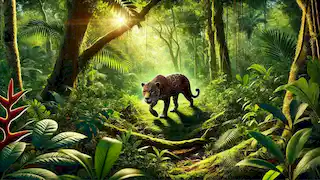
The first Europeans to encounter the Amazon were Spanish explorers led by Francisco de Orellana in 1541. On his expedition, Orellana and his men were astounded by the river's sheer size and the dense rainforest that surrounded it. They marveled at the incredible biodiversity and the tribes that lived along its banks. Orellana named the river after the fierce women warriors he encountered, who reminded him of the Amazonian warriors from Greek mythology.
Chapter 2: The River’s Journey
The Amazon River's journey is a testament to nature's raw power and beauty. Spanning approximately 4,345 miles, it is one of the longest rivers in the world. Its basin covers an area of over 2.7 million square miles, making it the largest drainage basin on the planet. This vast expanse includes diverse ecosystems, ranging from the snow-capped Andes to the tropical rainforests of Brazil.
As the river flows from the highlands of Peru, it traverses multiple countries, including Colombia, Ecuador, and Venezuela, before finally reaching Brazil, where it meanders through the heart of the Amazon rainforest. The river's course is dotted with numerous tributaries, each adding to its might and splendor. The Madeira, Negro, and Tapajós rivers are among the largest tributaries, contributing significantly to the Amazon's flow.
The Amazon River's immense volume discharges around 55 million gallons of water per second into the Atlantic Ocean. This massive outflow significantly influences the ocean's salinity and marine life, creating a unique and fertile environment that supports a wide array of species.
Chapter 3: Flora and Fauna
The Amazon rainforest, often referred to as the "lungs of the Earth," is home to an astonishing array of flora and fauna. The dense canopy of trees, towering over 200 feet in some places, forms a lush and vibrant green roof that shelters countless species. The forest floor, though shrouded in shadows, is equally teeming with life.
The Amazon basin is estimated to house around 390 billion individual trees, representing over 16,000 species. These trees include the iconic kapok, with its massive trunk and buttress roots, and the rubber tree, which has played a crucial role in the region's history and economy. Orchids, bromeliads, and countless other plants adorn the trees, adding splashes of color to the verdant landscape.
The animal life in the Amazon is equally remarkable. Jaguars, the apex predators of the jungle, silently stalk their prey, while giant anacondas slither through the underbrush and waterways. The river itself is home to piranhas, caimans, and the elusive pink river dolphins, which navigate the murky waters with ease.
Birds of every hue fill the skies and treetops. The vibrant macaws, toucans with their oversized bills, and the majestic harpy eagle are just a few of the avian residents. Insects, too, abound, from the iridescent blue morpho butterflies to the industrious leafcutter ants that march in orderly lines across the forest floor.
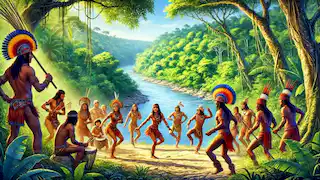
Chapter 4: Human Impact and Conservation
Despite its seemingly boundless beauty and resources, the Amazon River and its surrounding rainforest face significant threats from human activities. Deforestation, driven by logging, agriculture, and mining, has resulted in the loss of vast tracts of rainforest. This destruction not only diminishes biodiversity but also contributes to climate change by releasing stored carbon dioxide into the atmosphere.
The construction of dams for hydroelectric power poses another threat. While these dams provide electricity to millions, they disrupt the natural flow of the river, affecting fish migration patterns and displacing indigenous communities. Pollution from mining and agriculture also contaminates the river, endangering both human and animal health.
Efforts to conserve the Amazon are ongoing, with numerous organizations and governments working to protect this vital ecosystem. Conservation initiatives focus on sustainable development, reforestation, and the establishment of protected areas. Indigenous communities play a crucial role in these efforts, as their traditional knowledge and practices offer valuable insights into sustainable living.
Chapter 5: Mysteries and Legends
The Amazon River is not just a geographical wonder; it is also steeped in mystery and legend. Stories of lost cities, hidden treasures, and mythical creatures abound. One of the most famous legends is that of El Dorado, the city of gold that many explorers sought but never found. The dense jungle and the river's ever-changing course have kept these secrets well hidden.
Another enduring mystery is the phenomenon of the "Boiling River." Deep in the Peruvian Amazon, there exists a river where the water reaches near-boiling temperatures. This natural wonder has baffled scientists and fueled local legends. The indigenous people believe it is the work of powerful spirits, while geologists attribute it to underground geothermal activity.
The river's unique pink dolphins are also surrounded by folklore. According to local myths, these dolphins are shape-shifters that can transform into handsome young men. They emerge from the river during festivals, seducing young women before returning to their aquatic form. Such tales add to the river's allure and mystique.
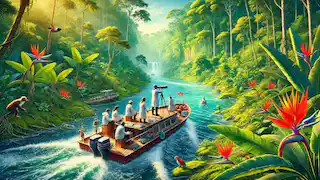
Chapter 6: Modern Exploration and Adventure
Today, the Amazon River continues to captivate adventurers and scientists alike. Modern explorers undertake expeditions to uncover its secrets and document its biodiversity. These journeys are often arduous, involving navigation through dense jungle, swamps, and unpredictable waters.
Scientific research in the Amazon is crucial for understanding global biodiversity and climate change. Researchers study the river's hydrology, the impacts of deforestation, and the unique adaptations of its flora and fauna. Their findings contribute to global conservation efforts and highlight the importance of preserving this critical ecosystem.
Tourism in the Amazon has also grown, offering visitors a chance to experience its wonders firsthand. Eco-tourism initiatives promote sustainable travel, allowing tourists to explore the rainforest while minimizing their environmental impact. River cruises, guided treks, and wildlife spotting are just a few of the activities that draw people to the Amazon.
Chapter 7: Cultural Significance
The Amazon River holds immense cultural significance for the people who live along its banks. For indigenous communities, it is more than just a source of sustenance; it is a central part of their identity and spiritual life. Their myths, rituals, and daily practices are intricately linked to the river and the forest.
These communities possess a profound understanding of the Amazon's ecosystems, passed down through generations. Their knowledge of medicinal plants, wildlife behavior, and sustainable hunting and fishing practices is invaluable. Efforts to involve indigenous people in conservation and sustainable development projects have shown promising results, highlighting the importance of their participation in preserving the Amazon.
The river also plays a vital role in the broader Brazilian culture. It has inspired countless works of art, literature, and music. The Boi Bumbá festival, celebrated in the Amazonian city of Parintins, is a vibrant display of local folklore, dance, and music, reflecting the cultural richness of the region.
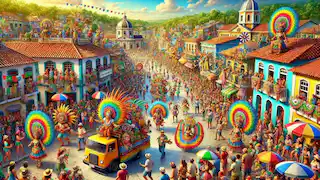
Chapter 8: The Amazon's Future
The future of the Amazon River and its rainforest is uncertain. The threats it faces are formidable, but so too are the efforts to protect it. Sustainable development, conservation initiatives, and global awareness are key to ensuring the survival of this vital ecosystem.
Technological advancements offer new tools for monitoring and protecting the Amazon. Satellite imagery, drones, and remote sensing technologies enable scientists to track deforestation, illegal activities, and changes in the river's flow in real-time. These tools enhance the ability to respond quickly to threats and implement effective conservation strategies.
International cooperation is also crucial. The Amazon basin spans multiple countries, requiring a collaborative approach to conservation. Agreements between nations, support from global environmental organizations, and sustainable development aid are essential components of a comprehensive strategy to protect the Amazon.
Ultimately, the fate of the Amazon River rests in the hands of humanity. It is a shared responsibility to safeguard this natural wonder for future generations. By recognizing its intrinsic value and implementing sustainable practices, we can ensure that the Amazon continues to thrive and inspire awe for centuries to come.
